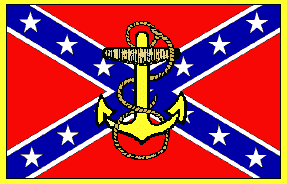


U.S.A. 35 Star Flag |

C.S.A. Navy Flag |
|||
SS Star of the West in the War of the Rebellion
At 4:30 A. M. on April 12, 1861, Confederate batteries opened fire on Fort Sumter, Charleston Harbor, South Carolina. The War of the Rebellion had begun.
Three months prior, First Lieut. Chas. R. Woods, Ninth Infantry, U.S.A., in command of 200 men, boarded the Star of the West bound for Charleston to re-enforce the troops of the United States at Fort Sumter. At "about midnight ... (on January 8)..." the Star of the West arrived off Charleston and groped around in the darkness until daylight. "We went into the harbor with the American ensign hoisted on the flagstaff, and as soon as the first shot was fired a full-sized garrison flag was displayed at our fore, but the one was a no more respected than the other. We kept on, still under the fire of the battery, most of the balls passing over us, one just missing the machinery, another striking but a few feet from the rudder, while a ricochet shot struck us in the fore-chains, about two feet above the water line, and just below where the man was throwing the lead. The American flag was flying at Fort Sumter, but we saw no flag at Fort Moultrie, and there were no guns fired from either of these fortifications." Unable to land his troops, Lieut. Woods and the Star of the West withdrew, as per the direct order of General Winfield Scott.
J. G. Foster, Captain, Engineers, U.S.A., was in command of a "small garrison of seventy men" at Fort Sumter. On January 9, 1861, he wrote General Totten, "The firing upon the "Star of the West" this morning by the batteries on Morris Island opened the war, but Major Anderson hopes that the delay of sending to Washington may possibly prevent civil war. The hope, although a small one, may be the thread that prevents the sundering Union."
On April 17, 1861, Confederate troops under the command of Colonel Van Dorn, C. S. A., captured the Star of the West, as she was anchored offshore near Matagorda Bay, Texas. Troops under the command of Major C. C. Sibley, Third Infantry, U.S.A., made two unsuccessful attempts to evacuate the area aboard the Star of the West but were unable to reach her anchorage. Thus, on April 25, 1861, Major Sibley reported the surrender of his battalion, "consisting of two companies of the First Infantry, with the adjutant and non-commissioned staff and band of the same regiment, three companies of the Third and two companies of the Eighth Infantry, including nine officers, to the forces of the Confederate States of America."
Aboard the steamer Hartford City, in the Yazoo River, March 2, 1863, Commodore I. N. Brown, C. S. Navy, reports that in defense of the city of Vicksburg, "A raft is in construction, and the Star of the West, steamer, is there on the Tallahatchee ready to be used as a an obstruction. Despite all these preparations, I think the fight for the Yazoo River must be made at Yazoo City, there being no strictly defensive position on the river from the Yazoo Pass to that point."
In a report of operations on the Yazoo and Tallahatchee rivers, by March
27, 1863, "The raft in an unfinished state was hastily swung across the
Tallahatchee and the Confederate States steamer "The old steamship Star of the West is sunk just below the raft
across the stream, and they have the John Walsh close to the same
place, either ready to sink or use as a boarding craft and ram."
Records also indicate that the Star of the West was re-named
the C.S.S. St. Philip. Regarding the disposition of C. S. S. ships,
official records note:
C.S.S. St. Philip Source:
The
War of the Republic: a Compilation of the Official Records of the Union
and Confederate Armies, published under the direction of the Secretary
of War, The Honorable Elihu Root, and Brig. Gen. Fred. C. Ainsworth, the
Chief of the Record and Pension Office, U.S. War Department (1880 - 1901).
The
Official Records of th Union and Confederate Navies in the War of the Rebellion,
published under the direction of the Secretary of Navy, The Honorable H.A.
Herbert, Lieut. Commander Richard Bush, Superintendent of Naval War records,
U.S. Navy, and Mr. Robert H. Woods in 1894.
© Copyright 2008 SFgenealogy. All rights reserved.
Acquisition. -- Captured at Indianola,
Tex.
Formerly U. S. Steamer Star of the West.
Description. --Receiving ship.
Disposition. -- Sunk at Fort Pemberton above mouth
of Yalobusha, in Tallahatchie River, Miss., as an obstruction.
Return
to California Bound main page
Return
to SFgenealogy